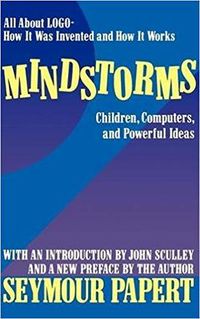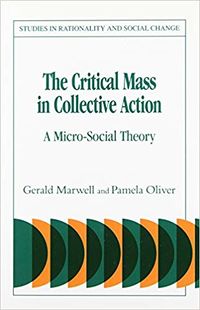Sociotechnocanonicon/2019 Schedule: Difference between revisions
(cleanup) |
|||
| (4 intermediate revisions by 2 users not shown) | |||
| Line 3: | Line 3: | ||
The reading group meets on https://meet.jit.si/sociotechnocanonicon every Tuesday, 11:30 - 1:00 PM Pacific time. | The reading group meets on https://meet.jit.si/sociotechnocanonicon every Tuesday, 11:30 - 1:00 PM Pacific time. | ||
== Mindstorms: Children, Computers, and Powerful Ideas == | === Mindstorms: Children, Computers, and Powerful Ideas === | ||
[[File:Mindstorms (book).jpg|thumb|200px|right]] | [[File:Mindstorms (book).jpg|thumb|200px|right]] | ||
| Line 19: | Line 19: | ||
** [http://web.media.mit.edu/~mres/papers/IJCCI-seeds-seymour-sowed.pdf The Seeds That Seymour Sowed] | ** [http://web.media.mit.edu/~mres/papers/IJCCI-seeds-seymour-sowed.pdf The Seeds That Seymour Sowed] | ||
== Collection Action == | === Collection Action === | ||
=== The Logic of Collective Action === | ==== The Logic of Collective Action ==== | ||
:Olson, M. (1965). The logic of collective action: Public goods and the theory of groups. Cambridge, MA: Harvard University Press. | :Olson, M. (1965). The logic of collective action: Public goods and the theory of groups. Cambridge, MA: Harvard University Press. | ||
| Line 29: | Line 29: | ||
* 2019-07-23: Read the entire book. Nate is facilitating. Chapters 1 and 2 are super classic and the reason the book is cited as much as it is. I expect that much of our discussion will focus on the first part of the book, but feel free to bring up the other parts as well. | * 2019-07-23: Read the entire book. Nate is facilitating. Chapters 1 and 2 are super classic and the reason the book is cited as much as it is. I expect that much of our discussion will focus on the first part of the book, but feel free to bring up the other parts as well. | ||
=== The Critical Mass in Collective Action === | ==== The Critical Mass in Collective Action ==== | ||
[[File:Marwell oliver critical mass.jpg|thumb|200px|right]] | |||
:Marwell, Gerald, and Pamela Oliver. 1993. ''The Critical Mass in Collective Action: A Micro-Social Theory''. Cambridge, UK: Cambridge University Press. | :Marwell, Gerald, and Pamela Oliver. 1993. ''The Critical Mass in Collective Action: A Micro-Social Theory''. Cambridge, UK: Cambridge University Press. | ||
| Line 38: | Line 41: | ||
** Fulk, Janet, Andrew J. Flanagin, Michael E. Kalman, Peter R. Monge, and Timothy Ryan. 1996. “Connective and Communal Public Goods in Interactive Communication Systems.” Communication Theory 6 (1): 60–87. https://doi.org/10.1111/j.1468-2885.1996.tb00120.x | ** Fulk, Janet, Andrew J. Flanagin, Michael E. Kalman, Peter R. Monge, and Timothy Ryan. 1996. “Connective and Communal Public Goods in Interactive Communication Systems.” Communication Theory 6 (1): 60–87. https://doi.org/10.1111/j.1468-2885.1996.tb00120.x | ||
** Butler, Brian S. 2001. “Membership Size, Communication Activity, and Sustainability: A Resource-Based Model of Online Social Structures.” Information Systems Research 12 (4): 346–62. https://doi.org/10.1287/isre.12.4.346.9703 | ** Butler, Brian S. 2001. “Membership Size, Communication Activity, and Sustainability: A Resource-Based Model of Online Social Structures.” Information Systems Research 12 (4): 346–62. https://doi.org/10.1287/isre.12.4.346.9703 | ||
** | ** Solomon, Jacob, and Rick Wash. 2014. “Critical Mass of What? Exploring Community Growth in WikiProjects.” In Proceedings of the Eighth International AAAI Conference on Weblogs and Social Media (ICWSM ’16). Palo Alto, CA: AAAI. http://www.aaai.org/ocs/index.php/ICWSM/ICWSM14/paper/view/8104 | ||
(Also may be of interest: Marwell & Oliver wrote their own retrospective ("Whatever Happened to Critical Mass Theory", https://doi.org/10.1111/0735-2751.00142) -khc | |||
Once again, there is PDF copy of the book and all articles in the group Zotero library. Contact [[Mako]] if you need one in some other way. The book is difficult and includes a bit of math and data. Don't try to start reading this the morning of. | |||
== Related pages in this wiki == | |||
* [[Sociotechnocanonicon/2018 Schedule]] | |||
* [[Sociotechnocanonicon/2019 Planning]] | |||
Latest revision as of 03:42, 13 October 2019
This schedule describes the summer 2019 reading plan for the Sociotechnocanonicon.
The reading group meets on https://meet.jit.si/sociotechnocanonicon every Tuesday, 11:30 - 1:00 PM Pacific time.
Mindstorms: Children, Computers, and Powerful Ideas[edit]
Mindstorms, Seymour Papert (The website has a link to downloadable PDF of the book as a single file.)
To try out the programming examples in the book, you can use an online version of Logo or download UCBLogo (available in Debian/Ubuntu/Arch Linux repositories). Note that the command to exit UCBLogo is bye.
- 2019-07-02 Week 1: Foreword, Introduction, Chapters 1-4 (pages vi-viii, 3-119)
- 2019-07-09 Week 2: Chapters 5-8, Epilogue (pages 120-207)
- 2019-07-16 Closing Week: Full work retrospective & follow-ups
Collection Action[edit]
The Logic of Collective Action[edit]
- Olson, M. (1965). The logic of collective action: Public goods and the theory of groups. Cambridge, MA: Harvard University Press.
There is a soft copy in the shared Zotero or you can ask in IRC to get access.
- 2019-07-23: Read the entire book. Nate is facilitating. Chapters 1 and 2 are super classic and the reason the book is cited as much as it is. I expect that much of our discussion will focus on the first part of the book, but feel free to bring up the other parts as well.
The Critical Mass in Collective Action[edit]
- Marwell, Gerald, and Pamela Oliver. 1993. The Critical Mass in Collective Action: A Micro-Social Theory. Cambridge, UK: Cambridge University Press.
- 2019-07-30 Week 1: Read Chapters 1-4 (pg 1-100) on "The critical mass and the problem of collective action"; "Building blocks: goods, groups, and processes"; "The paradox of group size"; and "The dynamics of production functions"
- 2019-08-06 Week 2: Read Chapter 5-8 (pg 101-193) on "Social networks: density, centralization, and cliques"; "Selectivity in social networks"; "Reach and selectivity as strategies of recruitment;" and "Unfinished business"
- 2019-08-13 Week 3: Applications to "our world" including [all available in Zotero]:
- Fulk, Janet, Andrew J. Flanagin, Michael E. Kalman, Peter R. Monge, and Timothy Ryan. 1996. “Connective and Communal Public Goods in Interactive Communication Systems.” Communication Theory 6 (1): 60–87. https://doi.org/10.1111/j.1468-2885.1996.tb00120.x
- Butler, Brian S. 2001. “Membership Size, Communication Activity, and Sustainability: A Resource-Based Model of Online Social Structures.” Information Systems Research 12 (4): 346–62. https://doi.org/10.1287/isre.12.4.346.9703
- Solomon, Jacob, and Rick Wash. 2014. “Critical Mass of What? Exploring Community Growth in WikiProjects.” In Proceedings of the Eighth International AAAI Conference on Weblogs and Social Media (ICWSM ’16). Palo Alto, CA: AAAI. http://www.aaai.org/ocs/index.php/ICWSM/ICWSM14/paper/view/8104
(Also may be of interest: Marwell & Oliver wrote their own retrospective ("Whatever Happened to Critical Mass Theory", https://doi.org/10.1111/0735-2751.00142) -khc
Once again, there is PDF copy of the book and all articles in the group Zotero library. Contact Mako if you need one in some other way. The book is difficult and includes a bit of math and data. Don't try to start reading this the morning of.


